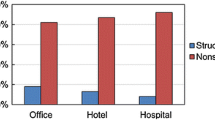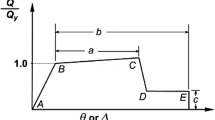Abstract
Seismic evaluation of existing reinforced concrete buildings that are classified as non-conforming to modern earthquake standards is an urgent priority, since this class of buildings represents the majority of the built environment throughout the world. To address this need a simple procedure for rapid seismic assessment (RSA) of the earthquake demand and available capacity of existing buildings has been devised and calibrated through field applications. RSA is based on first principles, considering the prevalent failure modes of the load bearing components of the structure, and easily accessible information regarding the geometric and material characteristics of the structure. In this paper the RSA method is further improved by introducing expressions for direct estimation of the local drift demands of the examined building at peak seismic response using the structure’s unique geometric and material properties. The accuracy of the RSA procedure is evaluated through application and comparison of the assessment results with the recorded seismic responses of two model experimental structures that had been tested under pseudo dynamic loads simulating earthquake effects, reported in the literature. The example structures were chosen because they were full-scale structures with relatively simple layout (planar frames), in order to develop an instructive paradigm of the RSA’s application for the interest of practitioners.














Similar content being viewed by others
References
Clough RW, Penzien J (1975) Dynamics of structures, 1st edn. McGraw-Hill Inc., New York
EN 1998-1 (2004) Eurocode 8—Design of structures for earthquake resistance—part 1: general rules, seismic actions and rules for buildings. European Committee for Standardization (CEN), Brussels
EN 1998-3 (2005) Eurocode 8—design of structures for earthquake resistance—part 3: assessment and retrofitting of buildings. European Committee for Standardization (CEN), Brussels
FEMA P-154 (2015) Rapid visual screening of buildings for potential seismic hazards: a handbook. Federal Emergency Management Agency (FEMA), Washington, DC
FEMA-356, Prestandard (2000) Commentary for the seismic rehabilitation of buildings. Federal Emergency Management Agency (FEMA), Washington, DC
FIB Bulletin 24 (2003) Seismic assessment and retrofit of reinforced concrete buildings, State-of-art report prepared by Task Group 7.1. Federation of Structural Concrete (FIB)
Greek Code of Structural Interventions 2012 (2012) Earthquake planning and protection organization of Greece (E.P.P.O.), Athens
Gülkan P, Sozen MA (1999) Procedure for determining seismic vulnerability of building structures. ACI Struct J 96(3):336–342
Gür T, Pay AC, Ramirez JA, Sozen MA, Johnson AM, Irfanoglu A, Bobet A (2009) Performance of school buildings in Turkey during the 1999 Düzce and the 2003 Bingöl earthquakes. Earthq Spectra 25(2):239–256. https://doi.org/10.1193/1.3089367
Initial Evaluation Procedure (IEP) Assessment (2017). New Zealand Society for Earthquake Engineering (NZSEE), Structural Engineering Society (SESOC) and NZ Geotechnical Society (NZGS). http://www.EQ-Assess.org.nz
Japan Building Disaster Prevention Association (JBDPA) (2001) Standard for seismic evaluation and guidelines for seismic retrofit of existing reinforced concrete buildings (English Edition)
Kappos AJ, Panagopoulos G, Panagiotopoulos C, Penelis G (2006) A hybrid method for the vulnerability assessment of R/C and URM buildings. Bull Earthq Eng 4(4):391–413. https://doi.org/10.1007/s10518-006-9023-0
Pantazopoulou SJ, Syntzirma DV (2010) Deformation capacity of lightly reinforced concrete members–comparative evaluation. In: Fardis M (ed) Advances in performance-based earthquake engineering. Geotechnical, geological and earthquake engineering, vol 13. Springer, Dordrecht, pp 359–371. https://doi.org/10.1007/978-90-481-8746-1_34
Pardalopoulos S, Thermou GE, Pantazopoulou SJ (2013) Screening criteria to identify brittle R.C. structural failures in earthquakes. Bull Earthq Eng 11:607–636. https://doi.org/10.1007/s10518-012-9390-7
Pardalopoulos SI, Pantazopoulou SJ, Lekidis VA (2018a) Simplified method for rapid seismic assessment of older R.C. buildings. Eng Struct 154:10–22. https://doi.org/10.1016/j.engstruct.2017.10.052
Pardalopoulos SI, Pantazopoulou SJ, Thermou GE (2018b) Seismic rehabilitation of substandard R.C. buildings with masonry infills. J Earthq Eng. https://doi.org/10.1080/13632469.2018.1453397
Priestley MN, Seible F, Calvi GM (1996) Seismic design and retrofit of bridges. Wiley, New York
Shiga T, Shibata A, Takahashi T (1968) Earthquake damage and wall index of reinforced concrete buildings. In: Proceedings of the Tohuku district symposium, archit. Institute of Japan, vol 12, pp 29–32
Thermou GΕ, Pantazopoulou SJ (2011) Assessment indices for the seismic vulnerability of existing R.C. buildings with masonry infill walls. Earthq Eng Struct Dyn 40(3):293–313. https://doi.org/10.1002/eqe.1028
Vamvatsikos D, Cornell CA (2002) Incremental dynamic analysis. Earthq Eng Struct Dyn 31(3):491–514. https://doi.org/10.1002/eqe.141
Vamvatsikos D, Pantazopoulou SJ (2016) Simplified mechanical model to estimate the seismic vulnerability of heritage unreinforced masonry buildings. J Earthq Eng 20(2):298–325. https://doi.org/10.1080/13632469.2015.1060583
Varum H (2003) Seismic assessment, strengthening and repair of existing buildings. Dissertation, Universidade de Aveiro
Yakut A (2004) Preliminary seismic performance assessment procedure for existing RC buildings. Eng Struct 26(10):1447–1461. https://doi.org/10.1016/j.engstruct.2004.05.011
Yakut A, Gülkan P, Sadik Bakir B, Tolga Yilmaz M (2005) Re-examination of damage distribution in Adapazari: structural considerations. Eng Struct 27(7):990–1001. https://doi.org/10.1016/j.engstruct.2005.02.001
Author information
Authors and Affiliations
Corresponding author
Appendix
Appendix
The individual strength terms of an R.C. column can be calculated using the following expressions, which represent the present state of the art at the field. Nevertheless, these expressions may be subject to change as the knowledge base in reinforced concrete leads to improved models for the individual mechanisms of resistance.
Flexural shear demand
Exhaustion of shear strength
Anchorage failure of longitudinal reinforcement
Lap failure of longitudinal reinforcement
Shear capacity of joints
Punching shear of slab-column connections
Limiting shear due to yield of beams’ longitudinal reinforcement
where,
-
ρℓ,tot = As,tot/(b·d) is the total longitudinal reinforcement ratio of a column with external dimensions h × b,
-
As,tot is the total area of the longitudinal reinforcement at the column’s critical section,
-
d is the column effective depth,
-
fy is the longitudinal reinforcement yield stress,
-
fc is the concrete compressive strength,
-
ξ (= x/d) is the normalized depth of compression zone,
-
v is the axial load ratio acting on the cross section (Ng+0.3q/(b·d·fc)),
-
Hcl is the column’s deformable length,
-
tanα = (h/d − 0.8·ξ)·d/Hcl, where a (≤ θv) is the angle of inclination of the diagonal strut created between the centroids of the compression zones at the top and bottom column cross sections of the column (this represents the strut forming by the axial load acting on the column according to (Priestley et al. 1996),
-
θv (= {45° when v < 0.10, 30° when v ≥ 0.25, whereas for 0.10 ≤ v < 0.25 θv is calculated from linear interpolation}) is the angle of sliding plane (i.e. θv is the angle forming between the longitudinal member axis and a major inclined crack developing in the plastic hinge region of the column). It determines the number of stirrup legs that are intersected by the inclined sliding plane,
-
hst is the height of the stirrup legs,
-
Atr is the total area of stirrup legs in a single stirrup pattern, which are intersected by the inclined sliding plane,
-
s is the stirrup spacing,
-
fst is the stirrup yield stress,
-
Lα is the anchorage length of the longitudinal reinforcement,
-
Db is the diameter of longitudinal reinforcing bars,
-
αhook is a binary index (1 or 0) to account for hooked anchorages (αhook = 0 ⟹ no hooks),
-
fb= 2· fb,o is the concrete bond stress, where fb,o= n1· (fc/20)0.5, n1 = {1.80 for ribbed bars; 0.90 for smooth bars}.
-
μfr is the friction coefficient (0.2 ≤ μfr ≤ 0.3 for smooth bars; 1.0 ≤ μfr ≤ 1.5 for ribbed bars),
-
Llap is the lap-splice length,
-
αb is a binary index (1 or 0) depending on whether ribbed or smooth reinforcement has been used,
-
Nb is the number of longitudinal bars in tension,
-
Ab is the area of a single tension bar,
-
ft = 0.3·f 2/3 c is the concrete tensile strength,
-
γj = {1.40 for interior joints; 1.00 for all other cases, whereas, for joints without stirrups these values are reduced to 0.4 and 0.3 respectively},
-
vj is the (service) axial load acting on the bottom of the column adjusted at the top of the joint (compression positive),
-
bj = (b + bbeam)/2 is the joint width, where bbeam is the web width of the adjacent beam,
-
dbeam is the beam depth,
-
ρj,horiz = Atr/(s·bj),
-
dsl is the slab depth,
-
ρℓ,sl is the total slab reinforcement ratio at the critical punching perimeter around the column, ucrit
-
ρbeam is the tension longitudinal reinforcement ratio of the beam (i.e. the total longitudinal reinforcement ratio of the beam section adjacent to the column if an interior connection is considered, or in the case of exterior connections the value of the top or bottom beam reinforcement ratio (whichever is largest)),
-
f beam y is the yield stress of the beam longitudinal reinforcement.
Rights and permissions
About this article
Cite this article
Pardalopoulos, S.I., Pantazopoulou, S.J. Rapid seismic assessment of two four-storey R.C. test buildings. Bull Earthquake Eng 17, 1379–1406 (2019). https://doi.org/10.1007/s10518-018-0500-z
Received:
Accepted:
Published:
Issue Date:
DOI: https://doi.org/10.1007/s10518-018-0500-z




